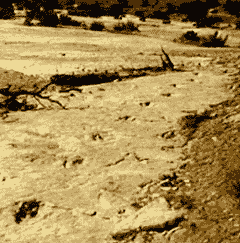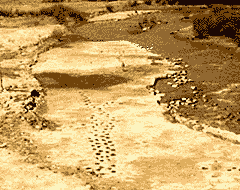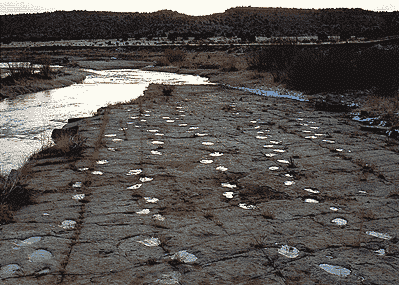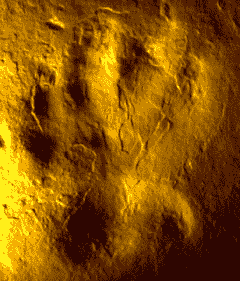| |
 | |
To someone who
spends their life attempting to imagine these long-dead animals as living, breathing
and moving creatures, there can be few sights more exciting than a line of footrpints
which has been made by a real animal. Unlike examing the bones, an image like
this presents and almost painfully tantalising glimpse back in time. Like a photograph,
it represents a living moment for an animal which walked that exact path more
than 65 million years ago. You can place the palm of your hand in an indentation
made right there by a dinosaur's foot. What
made these tracks?
This excellent set of deep tracks was made in soft
mud by a therapod dinosaur of some kind. |  | |
It has three toes
and a distinct deep impression made by the middle claw. Looking at this impression,
it has always been my feeling that normal therapod feet (such as that of Ceratosaurus
and Deltadromeus below) do not have the correct size configuration to have made
been the culprit. I feel that the middle toe needs to be significantly longer
than the two other digits to have made this track.
-- ------
------  |
 | |
In contrast to
the Therapod's small, three-toed print, the trackways below were made by very
different animals. Each impression is large and circular. They must have been
made by a pair of sauropods, one following the other, splashing through the shallows
of a lake 150 million years ago. We have been left clues. Crushed and fossilized
into one of the footprints is a fresh-water mollusc. Such molluscs still live
today and that particular species never inhabits water more that a metre deep.
The two lines of tracks are too close together for the animals to have been walking
side-by-side. By
comparing Mr. Attenborough with the man on the right we can see that the prints
are a little too small to have been made by the foot of an animal as large as
Diplodocus (unless its two juvenile Diplodocus). For the period and location I
propose a small Titanosaurid, perhaps Saltasaurus. |  | |
 ------ ------ |
| | |
Australian Massacre
A
quarry near the town of Winton, Australia bears remarkable witness to an event
100 million years ago. Set in what was once clay, 3300 footprints prepresenting
160 dinosaurs form the largest trackway in the world. The tracks were made by
three main types of dinosaur. A two groups of small animals made up of the plant-eating
"Wintanopus" and the carnivorous "Scartopus" were minding
their own business when suddenly a large therapod appeared. The tracks show it
striding confidently at first but then slowing, as if stalking the smaller animals.
Then panic. The footprints show the two small groups fleeing quickly. Perhaps
an attack by the Therapod began. | Wintanopus
(bottom left left) is "ichogenuses". That is names given from trace
fossils alone and none of the bones exist.
| This
magnificent set of trackways from Colarado (right) proves two things about sauropods
and helps in our understanding of a third. Firstly it shows that these large animals
did move in herds. | |

Secondly
it proves that these dinosaurs (and indeed, probably all others) did not
drag their tails along the ground. And thirdly is suggests that eggs were
abandoned and juveniles were not nurtured. It generally appears to be the case
that tracks such as these were all made by well-grown individuals together and
are not accompanied by young..
|
 |
|
Closer to home
About 200 million years ago, the land that would eventally
become my home town was in the middle of a tropical desert which covered most
of northern europe.
Possibly
at the edge of a lake, an animal named Chirotherium Storetonense was maybe taking
a drink when its hand-like front foot made this impression in the soft ground.
The sand of this muddy beach compacted over time and left my tiny corner of England
with its entry in the fossil record. A cast can now be seen at a nearby visitor's
centre along with a collection of small, possibly dinosaur prints. Credits:
Chris Bower, Fred Bervoets
Image material: Lost Worlds, Vanished Lives &
Jurassica |
Place
Saltwick,
Whitby
Forest Marble, Buckinghamshire
Inferior Oolite, North Yorkshire
Lower Deltaic Series, N Yorkshire
Middle Purbeck Beds, Dorset
Middle Purbeck
Beds, Dorset
Upper Estuarine Series, North Yorks
Wealden, East Sussex
Wealden, Isle of Wight
Wealden, Isle of Wight
Wealden, Surrey
Unnamed unit of Mercia Mudstone Group, South-Glamorgan
Lealt Shale Formation, Highland, Scotland |
|
-Dinosaur trackways in the UK Information Middle
Jurassic Theropod footprint
Bathonian Jurassic Middle Theropod
Aalenian
Bajocian Jurassic Middle Theropod
Aalenian Jurassic Middle Theropod
Tithonian Jurassic Late Ornithischian
Tithonian Jurassic Late Theropod
Bathonian Jurassic Middle Theropod
Valanginian Hauteravian Barremian Cretaceous
Early Ornithopod prints
Valanginian Hauteravian Barremian Cretaceous Early
Ornithopod prints
Valanginian Hauteravian Barremian Cretaceous Early Theropod
prints
Valanginian Hauteravian Barremian Cretaceous Early Ornithopod prints
Norian
Triassic Late Theropod footprints
Bathonian Jurassic Middle Ornithopod
| |
|


 ------
------ 

 ------
------



